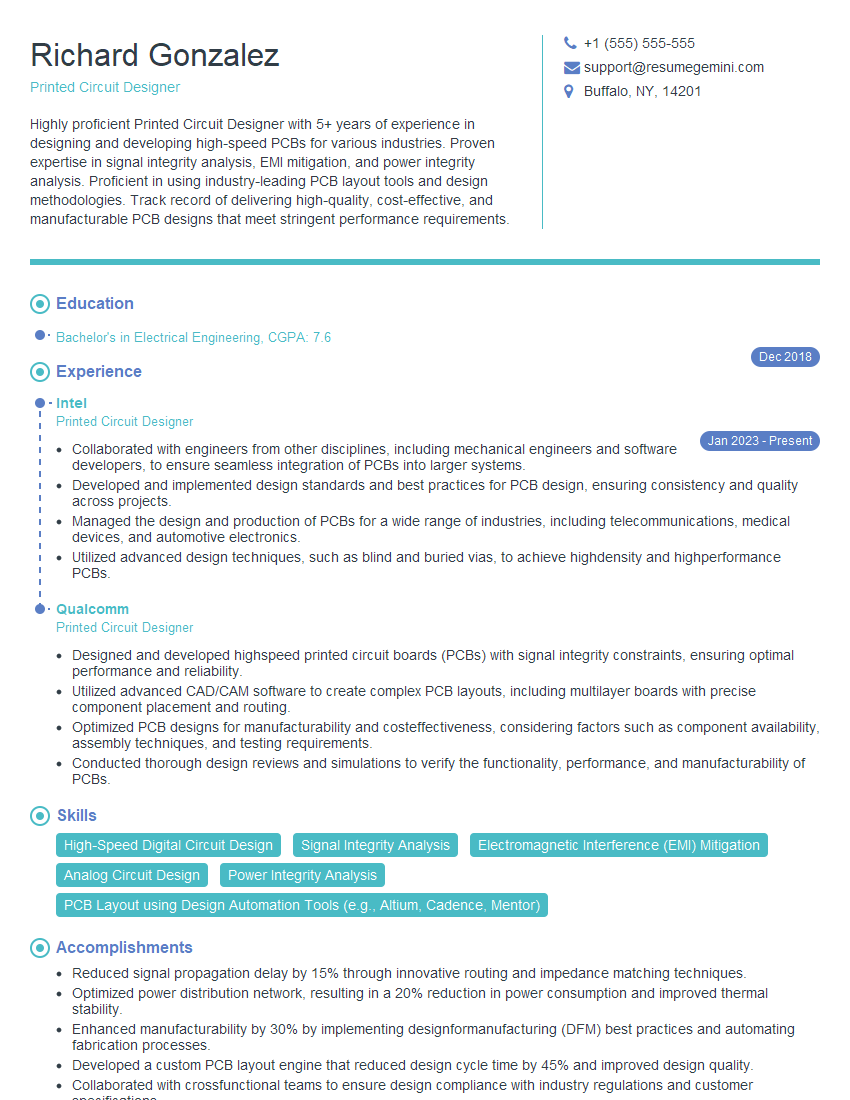Are you a seasoned Printed Circuit Designer seeking a new career path? Discover our professionally built Printed Circuit Designer Resume Template. This time-saving tool provides a solid foundation for your job search. Simply click “Edit Resume” to customize it with your unique experiences and achievements. Customize fonts and colors to match your personal style and increase your chances of landing your dream job. Explore more Resume Templates for additional options.

Richard Gonzalez
Printed Circuit Designer
Summary
Highly proficient Printed Circuit Designer with 5+ years of experience in designing and developing high-speed PCBs for various industries. Proven expertise in signal integrity analysis, EMI mitigation, and power integrity analysis. Proficient in using industry-leading PCB layout tools and design methodologies. Track record of delivering high-quality, cost-effective, and manufacturable PCB designs that meet stringent performance requirements.
Education
Bachelor’s in Electrical Engineering
December 2018
Skills
- High-Speed Digital Circuit Design
- Signal Integrity Analysis
- Electromagnetic Interference (EMI) Mitigation
- Analog Circuit Design
- Power Integrity Analysis
- PCB Layout using Design Automation Tools (e.g., Altium, Cadence, Mentor)
Work Experience
Printed Circuit Designer
- Collaborated with engineers from other disciplines, including mechanical engineers and software developers, to ensure seamless integration of PCBs into larger systems.
- Developed and implemented design standards and best practices for PCB design, ensuring consistency and quality across projects.
- Managed the design and production of PCBs for a wide range of industries, including telecommunications, medical devices, and automotive electronics.
- Utilized advanced design techniques, such as blind and buried vias, to achieve highdensity and highperformance PCBs.
Printed Circuit Designer
- Designed and developed highspeed printed circuit boards (PCBs) with signal integrity constraints, ensuring optimal performance and reliability.
- Utilized advanced CAD/CAM software to create complex PCB layouts, including multilayer boards with precise component placement and routing.
- Optimized PCB designs for manufacturability and costeffectiveness, considering factors such as component availability, assembly techniques, and testing requirements.
- Conducted thorough design reviews and simulations to verify the functionality, performance, and manufacturability of PCBs.
Accomplishments
- Reduced signal propagation delay by 15% through innovative routing and impedance matching techniques.
- Optimized power distribution network, resulting in a 20% reduction in power consumption and improved thermal stability.
- Enhanced manufacturability by 30% by implementing designformanufacturing (DFM) best practices and automating fabrication processes.
- Developed a custom PCB layout engine that reduced design cycle time by 45% and improved design quality.
- Collaborated with crossfunctional teams to ensure design compliance with industry regulations and customer specifications.
Awards
- Recognized with the Excellence in PCB Design award for exceptional contributions to highspeed circuit designs.
- Received the PCB Design Innovation Award for pioneering a novel approach to mitigate signal integrity issues.
- Conferred the Best PCB Design award for achieving exceptional performance and reliability in missioncritical applications.
- Honored with the Engineer of the Year award for outstanding contributions to the field of PCB design.
Certificates
- Certified Printed Circuit Board Designer (CPBD)
- IPC-CID Certified (Certified Interconnect Designer)
- CID+ (Certified Interconnect Designer Plus)
- CAMT (Certified Advanced Manufacturing Technologist)
Career Expert Tips:
- Select the ideal resume template to showcase your professional experience effectively.
- Master the art of resume writing to highlight your unique qualifications and achievements.
- Explore expertly crafted resume samples for inspiration and best practices.
- Build your best resume for free this new year with ResumeGemini. Enjoy exclusive discounts on ATS optimized resume templates.
How To Write Resume For Printed Circuit Designer
- Highlight your expertise in high-speed digital circuit design and signal integrity analysis, as these are critical skills for PCB designers.
- Showcase your proficiency in using industry-standard PCB layout tools and design methodologies.
- Quantify your accomplishments by providing specific examples of PCB designs you have developed and their impact on product performance.
- Demonstrate your understanding of manufacturing processes and your ability to optimize PCB designs for manufacturability.
Essential Experience Highlights for a Strong Printed Circuit Designer Resume
- Designed and developed high-speed PCBs with signal integrity constraints, ensuring optimal performance and reliability.
- Utilized advanced CAD/CAM software to create complex PCB layouts, including multilayer boards with precise component placement and routing.
- Optimized PCB designs for manufacturability and cost-effectiveness, considering factors such as component availability, assembly techniques, and testing requirements.
- Conducted thorough design reviews and simulations to verify the functionality, performance, and manufacturability of PCBs.
- Collaborated with engineers from other disciplines, including mechanical engineers and software developers, to ensure seamless integration of PCBs into larger systems.
- Developed and implemented design standards and best practices for PCB design, ensuring consistency and quality across projects.
Frequently Asked Questions (FAQ’s) For Printed Circuit Designer
What are the key skills required for a Printed Circuit Designer?
Key skills for a Printed Circuit Designer include expertise in high-speed digital circuit design, signal integrity analysis, and PCB layout using design automation tools.
What industries employ Printed Circuit Designers?
Printed Circuit Designers are employed in a wide range of industries, including telecommunications, medical devices, automotive electronics, and consumer electronics.
What are the career prospects for a Printed Circuit Designer?
Printed Circuit Designers with strong skills and experience are in high demand, and the job outlook is expected to remain positive in the coming years.
What is the salary range for a Printed Circuit Designer?
The salary range for a Printed Circuit Designer can vary depending on experience, skills, and location. However, according to Indeed, the average salary for a Printed Circuit Designer in the United States is around $85,000 per year.
What are the educational requirements for a Printed Circuit Designer?
Most Printed Circuit Designers hold a Bachelor’s degree in Electrical Engineering or a related field.
What are the certification options available for a Printed Circuit Designer?
There are several certification options available for Printed Circuit Designers, including the Certified Printed Circuit Designer (CPCD) certification offered by the Institute for Printed Circuits (IPC).